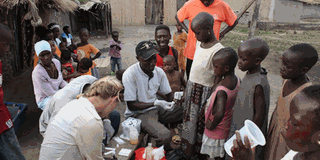Ministry launches larvicides for malaria fight

Malaria in Uganda is responsible for more illness and death than any other disease. While pregnant women, children under five years and people living with HIV/Aids are particularly vulnerable, all people living in Uganda are at risk of being infected with malaria parasites and suffering from resulting illness.
What you need to know:
The new method meant to complement those already existing, involves applying chemicals in mosquito-breeding areas to kill larva.
The Ministry of Health has introduced larvicides as an alternative in the fight against malaria as the country struggles to eliminate the disease by 2020.
Larviciding will complement the already existing public health interventions such as timely diagnosis and treatment, use of long lasting insecticide-treated mosquito nets and indoor residue spray.
The new technique involves application of chemicals or biological agents to mosquito breeding habitats to kill mosquito larva.
Dr Grace Nambatya, the chairperson technical coordination committee of the larviciding programme, said the ministry has chosen to explore the method as a way of reducing vector breeding sites to the strictest minimum wherever possible.
“We will be spraying outside and targeting breeding sites of anopheles mosquitoes, which are the malaria vectors,” Ms Nambatya said.
Ms Nambatya was representing the Health Minister, Dr Christine Ondoa, at the launch of larvicide method at Wakiso District Headquarters on Tuesday.
As part of the integrated vector management approach, she said they will apply a locally-available product called Temophos (Abate), which has been used in the eradication of Guinea worms on mosquito breeding sites in northern Uganda.
The chemical is also currently being used for onchocerchiasis (river blindness) control in Hoima District and is the same insecticide widely used in animal disease control interventions in the country.
In Uganda, malaria is the number one cause of death, morbidity and poverty.
According to statistics, the country spends $658m (about Shs1.6 trillion) to malaria annually, which is equivalent to 10 per cent of the Ministry of Health budget.
Dr Myers Lugemwa of the National Malaria Control Programme (NMCP), said Uganda is ranked fourth next to Democratic Republic of Congo among the most malaria-infested countries in the world.
Mr Vicent Katamba, of NMPC said initial application of SAFE larvicides will be done in Wakiso District before the project is extended to other districts.
He added that the chemicals will be used in both man-made and natural breeding sites in the district.
These would include burrow pits, ponds, pools, roadside pools, channels and river bed pools among others.



